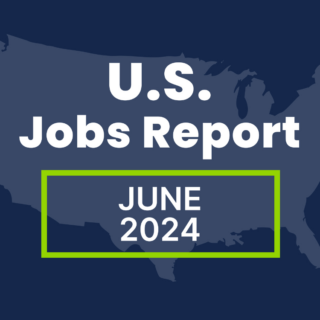Hiring the right candidates is critical for any healthcare organization looking to stay ahead of the challenges facing the healthcare industry. However, the terminology and processes involved in the world of healthcare recruiting and talent acquisition can seem daunting. Below, we provide a healthcare recruiting reference glossary to help you decipher healthcare recruiting terminology.
Common Healthcare Recruiting Terms
Allied Health Personnel: Trained and licensed healthcare workers other than physicians, dentists, optometrists, chiropractors, podiatrists, and nurses. The term is sometimes used synonymously with paramedical personnel, all healthcare workers who perform tasks that must otherwise be performed by a physician, or health workers who do not usually engage in independent practice.
Dig Deeper
How RPO Can Solve The Top Challenges In Healthcare Talent Acquisition
Applicant Tracking System (ATS): An ATS is a software application that enables the electronic management of recruitment functions. An ATS stores candidate data to allow recruiters or hiring managers to search, filter and route applications. ATS software can also be known as Talent Management Software (TMS), Candidate Management System (CMS) or Recruitment Management System (RMS), with some ATS platforms being tailored or designed specifically for healthcare recruiting. ATS solutions are often used in conjunction with an RPO program for more efficient hiring.
Assignment: An assignment is a temporary task, project or job performed by a contingent worker. Assignments may also refer to the length of time a temporary employee, such as a traveling nurse, will be working for a healthcare organization.
Blended Workforce: A blended healthcare workforce uses both full-time and contingent, or temporary, workers. Blended healthcare workforce planning uses both RPO and MSP programs to fill positions and manage talent and vendor services.
Business Intelligence (BI): BI tools provide a powerful analysis of program-specific data and metrics. BI tools are used with RPO, MSP and Total Workforce Solutions programs and provide transparency between a healthcare organization and healthcare staffing providers.
Business Process Outsourcing (BPO): BPO uses third-party business service providers to perform business activities and functions vital for running an efficient healthcare organization. BPO services may include payroll, medical coders, insurance specialists, healthcare IT, HR, accounting or customer service.
Candidate: A candidate is a person who has applied for a job and is qualified for temporary or full-time consideration by a healthcare organization. Candidates can apply to positions that are managed by an internal healthcare HR team or a Healthcare RPO provider.
Consultant: A consultant is another term used for temporary employees or contingent workers. Consultants often perform professional work for healthcare departments such as IT, medical billing, revenue cycle management, policy, project management and clinical roles.
Contingent Worker: Contingent is an overarching term that covers freelancers, independent contractors, consultants or any other outsourced, non-employee workers. They are generally hired on a per-project or temporary basis.
Clinical Staff: Clinical roles often have face-to-face contact with patients for the purpose of diagnosis, treatment and ongoing care. Some clinical professions are behind-the-scenes, such as laboratory professionals whose work supports diagnosis and treatment. Clinical roles often require certification or licensing by the state and local government.
Contingent Workforce Management (CWM): CWM is the strategic approach to managing an organization’s contingent workforce.
Contract Worker: A contract worker is also known as a 1099 or independent contractor. There are very specific guidelines for classifying workers as independent contractors, including whether the worker controls when and where work is to be completed if the worker provides their own work equipment and supplies, and how the workers are compensated.
Customer (or Contact) Relationship Management (CRM): CRM systems manage a company’s interaction with current and prospective customers or contacts – including employees.
Direct Hire: Direct hire positions are permanent, usually full-time with benefits.
Diversity Supplier: Diversity suppliers refer to minority, woman, disabled or veteran healthcare recruiting and staffing suppliers.
Employee: An employee works directly for an organization in a job with no specific end date. Employees may be full-time or part-time.
Employer Branding: A talent acquisition strategy designed to make a healthcare organization an appealing place to work. This targeted marketing effort attempts to shape the perceptions of potential candidates and current employees.
Employer Value Proposition (EVP): A unique set of offerings, associations and values to positively influence target candidates and employees. EVP benefits recruiting, healthcare employee engagement and retention and can reduce the need to pay a wage premium for top talent.
Exempt Workers: An exempt worker must be paid at least $23,600 per year on a salary basis and perform exempt job duties Exempt workers are not entitled to overtime pay for hours worked outside of normal 40-hour work week.
Healthcare Locum Tenens Staffing: Staffing of physicians, advanced practitioners, physician assistants, nurse practitioners, nurse anesthetists and dentists who take temporary assignments which involves temporary relocation and staffing firm coverage of housing expenses. Locum tenens workers are typically paid as independent contractors rather than employees.
Healthcare Skills Gap: The healthcare skills gap is the difference between the skills required for a healthcare job and the actual skills possessed by a candidate or employee tasked with the job.
Healthcare Staffing Services: Provide temporary hires that include supplemental staffing to medical facilities such as hospitals, nursing homes and outpatient clinics as well as the provision of licensed nursing personnel RNs, trained medical technologists, and unlicensed staff home health aides, homemakers, personal assistants, etc.
Healthcare Workforce Planning: The process a healthcare organization takes to develop a holistic, long-term and proactive approach to strategically assessing and accessing all forms of talent. Specifically, healthcare workforce planning links strategic objectives and their associated workforce implications with multiple avenues of talent engagement and resourcing such as direct hire, contingent, SOW and temporary staffing.
Non-Exempt Workers: Non-exempt workers are entitled to overtime pay for work done outside of a standard 40-hour work week.
Independent Contractor (1099): The general rule, according to the IRS, is that an individual is an independent contractor if the employer has the right to control or direct only the result of the work and not what will be done and how it will be done. Independent contractors are also known as contractors or freelancers or gig workers.
Job Board: Job boards are internet-based talent acquisition websites that aggregate either local, national or international job offerings.
Job Requisitions: Refers to a request to a staffing firm or employment agency to supply applicants for a specific position. A job order is the specific set of requirements set forth by an employer for an actual open position.
Per Diem Nurse Staffing: Staffing of registered nurses, licensed practical and licensed vocational nurses and nursing assistant on assignments of less than four weeks, which typically does not involve relocation for the worker.
Permanent Physician Staffing: Staffing an open physician position with a permanent hire.
Predictive Analytics: In an HR and healthcare recruiting context, this refers to the ability for a healthcare organization to use information and analytics to determine future outcomes for better workforce management. For example, predictive analytics may be used to analyze data from resumes, job descriptions, ATS and HRIS systems to predict various talent management outcomes.
Pre-employment screening: Pre-employment screening services are critical to healthcare staffing, ensuring candidates are certified and include background verification, drug screening, skills assessment and behavioral assessment tools. A thorough background screen verifies important factual information about a prospective employee (i.e. identity, employment history, education credentials). It also helps gain critical information about an applicant’s character and past history that isn’t always apparent in an interview or application, such as criminal history, credit history, driving record, etc.
Key Performance Indicator (KPI): A KPI is a measurable goal that demonstrates how effectively a company is achieving key business objectives. Organizations use KPIs to evaluate their success related to specific business metrics.
Machine Learning: Machine learning is a type of artificial intelligence (AI) that provides computers the ability to learn without being explicitly programmed. In an HR setting, an example of machine learning is the ability for a computer program to identify patterns and relationships in data to predict a specific outcome such likelihood of a candidate changing jobs within a certain period of time.
Managed Service Provider (MSP): MSP programs provide end-to-end workforce and vendor management for users of contingent labor.
Non-Clinical Healthcare Staffing: Non-clinical staffing encompasses positions in a healthcare setting such as front and back-office roles across a variety of departments and patient care settings.
Non-Traditional versus Traditional Employee Benefits: Traditional benefits include life, retirement, health and disability benefits. Non-traditional benefits include various types of perks such as child and elder care options, work-from-home days, casual dress code, lunch allowances, etc.
Recruitment Process Outsourcing (RPO): RPO programs provide direct-hire talent acquisition services for professional and non-professional positions that solve compliance, scalability, cost, quality or other recruiting challenges.
Service Level Agreement (SLA): An SLA is a commitment between a service provider and customer. Aspects of the partnership – quality, availability, responsibilities – are agreed upon between the service provider and the service user.
Social Media Healthcare Recruiting: Social media recruiting is a technique that sources or recruits candidates through the use of social media platforms as promotional and/or advertising channels.
Statement of Work (SOW): An SOW is a document that captures the work activities and deliverables to be supplied as part of a contract or project timeline. SOW arrangements are used in contingent workforce programs.
Supplemental Staffing: The provision of temporary workers to a company to supplement the current workforce for peak loads, special projects, or planned and unplanned worker absences. Also describes the regular practice of using contract healthcare staff in hospitals and other medical institution settings.
Temporary Workers: Temporary workers are generally hired to fill short-term positions or to complete specific projects with a set time frame. Temporary workers also fill positions that have irregular or seasonal work schedules.
Temp-to-Hire Workers: A temp-to-hire worker is hired as a temporary worker with the knowledge that the short-term position may transition to a full-time job. Temp-to-hire workers can be managed by an MSP program and then transitioned to the employer once they become permanent employees.
Total Workforce Solutions: Total Workforce Solutions blend Recruitment Process Outsourcing (RPO) and Managed Service Provider (MSP) capabilities in one integrated program.
Travel Nurse Staffing: Staffing of primarily registered nurses (RNs) on assignments of four weeks or more. A traveling nurse assignment can involve temporary relocation and housing expenses are paid for by an employer, but not always. Despite the use of the word “travel,” local nurses are sometimes used for travel assignments. The most common assignment length is 13 weeks, which may be renewed.
Vendor Management System (VMS): VMS platforms help businesses manage and procure staffing services – temporary, and, in some cases, permanent placement services – as well as outside contract or contingent labor. VMS platforms are generally used with MSP programs.
Workplace Diversity: Workplace diversity refers to a collective mixture of differences and similarities that may include: individual and organizational characteristics, values, beliefs, experiences, backgrounds, preferences and behaviors.
Regardless of the size of a healthcare organization, recruiting the right candidates is an integral part of growth and sustainability. By understanding some of the most commonly used terms in healthcare recruiting, you will be better equipped to meet with healthcare recruiting service providers and more efficient in sourcing, screening and hiring top healthcare talent.



